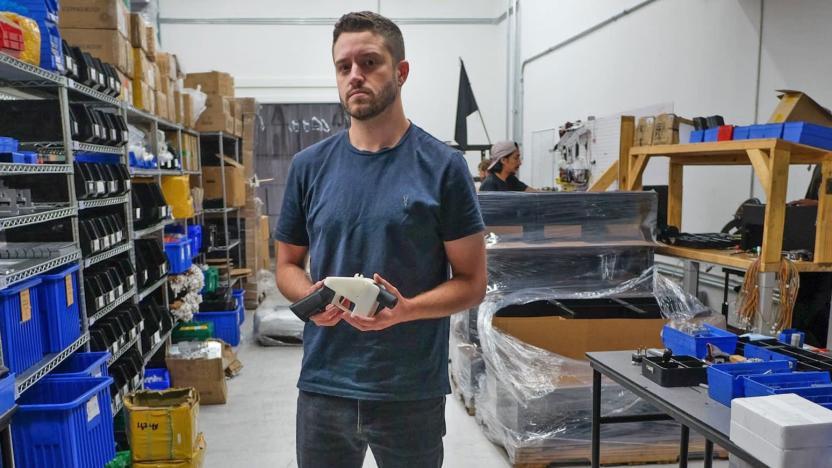microwaves
Latest

After Math: To infinity... and Taiwan!
Apparently, this was the week to shoot for the Moon, in some ways more literally than others. SpaceX announced on Monday that it'd found its first Guinea Pi- I mean "paying customer" for a slingshot sightseeing trip around the far edge of la luna and back. 3D-printed guns' strongest advocate made a break for the hills (of Taiwan) after being accused of sexually assaulting a 16-year-old, Telltale Studios told virtually all of its employees to start looking for alternative employment opportunities, and Amazon is hawking a bargain-basement microwave because they'll put a digital assistant in anything these days.

Embassy 'sonic attacks' may have been microwave blasts
When researchers postulated that the "sonic attacks" on embassies in Cuba (and more recently China) were the fault of malfunctioning surveillance gear, that wasn't the end to concerns about the true cause... if anything, there's more worry than ever. The University of Pennsylvania's Douglas Smith (who led a paper discussing the trauma of embassy victims) said in an interview that microwave blasts are now considered primary candidates. The concussion-like symptoms more closely line up with microwaves and other radio frequency-related illnesses than previous explanations, including straightforward acoustic attack, anxiety or viruses.

'Impossible' EM drive may actually be impossible after all
If something sounds too good to be true then it probably is, so goes the old saying. And unfortunately, it now seems this is also applicable to the "impossible" EM drive, first touted over a decade ago as a way to generate thrust using microwaves, thereby eliminating the need for fuel in deep space exploration. The initial research caused huge excitement, with scientists venturing it would be possible to travel from Earth to Mars in just a few weeks if the technology could be scaled up, but new tests suggest that's unlikely to happen because it doesn't appear to work at all.

The Morning After: Tuesday, March 14 2017
Welcome to Tuesday. Intel has just spent over $15 billion shoring up its self-driving car tech, you'll be playing PS4 games, officially and legally, on your PC and we explain how a microwave works. Because it certainly isn't a camera.

NASA successfully tests microwave thruster, paving the way for speedier space travel
As with airplanes and many other self-powered machines, the fuel a shuttle engine requires can weigh nearly as much as the object it's propelling, increasing costs while significantly limiting range. It's a challenge we're going to need to overcome before launching long-distance treks through space, where carrying enough fuel may not currently be possible. One proposed method for getting future spacecrafts to their destinations is by utilizing a device called a microwave thruster. A British scientist named Roger Shawyer managed to build a similar engine called an EmDrive several years ago, and while a Chinese team also accomplished the same, the rest of the world hasn't paid much attention until NASA confirmed from its own research that such a device could work during a presentation earlier this week.

Boeing tests microwave missile that knocks out electronics, represents our worst nightmare (video)
Forget bombs or the robopocalypse. In our minds, the most fearsome weapon is the one that disables our gadgets. That's what makes Boeing's newly tested Counter-electronics High-powered Microwave Advanced Missile Project (CHAMP) scarier than most projectiles. The missile bombards targets underneath with microwaves that shut down computers, power systems and just about anything electrical in their path. Thankfully, CHAMP's invisible payload arrives in discrete bursts and arguably makes it the world's most advanced (and likely expensive) non-lethal weapon: the prototype can target multiple individual buildings without ever having to detonate and hurt someone. Boeing is still developing CHAMP in a multi-year program and doesn't have guarantees that it will become military ordnance, which gives us enough time to accept that saving lives is far, far more important than the risk we'll have to stop fiddling with our technology.

Raytheon readying directed energy warheads to fry enemy electronics, cook allied Pop Tarts
Raytheon, the people who brought you the pain ray, are at it again. The defense giant is planning an arsenal of "directed energy warheads" expected to use radio and microwaves to electronically neutralize targets rather than blow them up. The company's being typically secretive about details, but mentions the recent acquisition of Ktech, a firm specializing in airborne electronic warfare and enemy vulnerability assessment, giving us a clue about how it might all work. It's believed the tech will be retrofitted to existing missiles: the new payloads will identify vulnerable electronics then disrupt or even destroy them with a radio frequency beam or high-powered microwaves (HPM). The warheads would monitor the results, providing valuable battlefield intelligence -- while, of course, killing fewer dudes on the ground. With industry rival BAE working on a seaworthy microwave gun to fry boat engines, we're looking forward to future of friendly drones circling overhead, always ready to heat up our Hot Pockets.

Poker chip-sized device non-invasively measures brain temperature, intrigues Le Chiffre
Do you ever feel like Portal 2 is making your brain overheat? You should get that checked, and thanks to researchers in Norfolk, Virginia, there's an easier way to do so. The Children's Hospital of The King's Daughters has developed a device the diameter of a poker chip that sits atop a patient's head; by detecting the microwaves that all human tissues produce, it calculates brain temperature without the need for messy skull-popping. The waves pass through the bone to give doctors precise, up-to-the-minute results, which can help prevent brain damage due to overheating. One possible use for the technology is helping hypoxic (oxygen lacking) infants, who can be treated with cooling therapies. Of course, you can probably make do with that old home remedy: just put a bag of frozen carrots on your head next time GlaDOS has you stumped.

US government contractor developing 'microwave gun,' Hot Pockets tremble
Ah, the beloved "electronic bomb," able to disable all technology in its vicinity: variations on the concept go way back, but useful prototypes remain tantalizingly out of reach. Into the breach steps defense contractor BAE Systems, taking a fresh crack with a High-Powered Microwave (HPM) gun intended to disable small boat engines – if successful, the technology may also target ships, UAVs, and missile payloads. The secret-shrouded weapon sounds similar to Boeing's planned airborne EMP weapon, but lacking the missile delivery systems. BAE seems to be betting big on electromagnetic warfare as a future battlefield tactic, with a manager pitching the sci-fi scene to Aviation Week: "Unlike lasers, HPM beams don't need a lot of accuracy. With a fan [of HPM energy] you can target 10-30 small boats. If you can knock out 50-75% of the engines in a swarm, you can then concentrate on the remainder with lasers or kinetic [cannons]." To develop better defenses against such attacks, the contractor received $150,000 from the Air Force to test-fire microwaves at military computers. No word on whether said defenses involve generous use of tin foil.

European R&D advances 'internet of things,' hastens our Phildickian future
Why can't our refrigerator fire off an urgent email when the milk has gone lumpy? And the toilet paper dispenser warn us it's empty – before we sit down? And when will our microwaves run BitTorrent? EUREKA, the European R&D network, knows how badly you crave networked objects, and rather than mock you, it's moving to help. To that end, it has developed small, inexpensive, battery-powered sensors able to link everything from consumer electronics to environmental monitors to factory robots – creating the much-anticipated "Internet of Things." But unlike the over-hyped RFID, it's technology you'd actually use. Instead of knowing whether your keys are indeed on the RFID reader, the network could gently remind you that you left them in your car, which is now 100 miles away with someone else at the wheel, but, luckily for you, low on gas. Gaze into the so-called future of things with EUREKA's press release, conveniently embedded after the jump.

Handheld millimeter / microwave camera to see through walls, your underpants (video)
You know those scanners that peep your naughty bits at the airport? Well, a team of researchers have been working on a handheld camera that sports the same technology, and while they're touting its future impact on stuff like cancer detection and aerospace engineering, we can't help but squirm thinking about its Peeping-Tom potential. The camera currently takes 30 images per second by transmitting millimeter and microwaves to a "collector" on the other side of a subject, and then sends them to a laptop for real-time inspection. Aside from being able to see straight through your BVDs, it can also be used to detect defects in spacecraft insulation, find termites lurking in the walls of your apartment, and help in the diagnosis of skin disease. The camera's creators are working on a smaller, one-sided version of the device that could have mass-market appeal -- we just hope this thing stays in R&D long enough for us to get our bikini bodies back. Check out a video of its G-rated abilities after the break.

Researchers develop infrared vegetable harvesting robot, to the disgust of children everywhere
Researchers at England's National Physical Laboratory are working on a device that uses a modified microwave measurement system, terahertz and far-infrared radio frequencies, and a clever cauliflower detection algorithm to let robots "see" beneath -- and harvest -- crops that current technology cannot. So far, the imaging system has been successfully demonstrated in the lab, sparking the interest of at least one UK lettuce grower, and it looks like a product could be commercially available as early as next year. According to Dr. Richard Dudley, Project Lead at NPL, the team began by focusing on cauliflower crops because they're both "one of the hardest" to measure, and totally gross.

Inventors claim to turn 300 microwaves into megawatt energy weapon
If you happen to have say, 300 microwaves kicking around between you and your friends, it turns out that you'd have a large part of the ingredients necessary for a pretty substantial weapon. That is, according to two New Mexican inventors, who recently filed a patent for a "high-power microwave system employing a phase-locked array of inexpensive commercial magnetrons." Translated into English that basically means that these guys claim you can combine the magnetrons (the bits that generate the actual microwave that cooks your popcorn) from a bunch of consumer-grade microwaves and tweak 'em a bit to develop a megawatt-level death ray, or in military/legal parlance, a "directed energy weapon system." Yeah, we've seen energy weapons (or tools, if you prefer) before, but this is probably one of the first times that we've seen ordinary kitchen technology more complicated than a knife turn into a seriously lethal weapon. [Via New Scientist]






